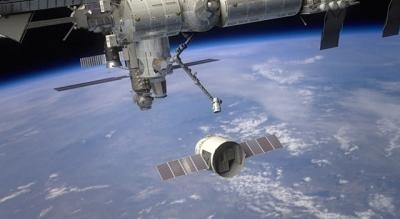Fri, Oct 05, 2012
Each Will Study The Effects Of Microgravity On Physical, Chemical, Or Biological Systems
Twenty-three microgravity experiments designed by participants of the Student Spaceflight Experiment Program (SSEP) will become part of space history Oct. 7. They will be launched to the International Space Station aboard the SpaceX Dragon, the first commercially developed and built American spacecraft to fly a resupply cargo resupply mission to the station. Twelve of the SSEP experiments are getting a second flight opportunity. They were delivered to the space station on a SpaceX demonstration mission in May, but were not completed. The other 11 experiments are new.

Each experiment will study the effects of microgravity on physical, chemical and biological systems. The students have been immersed in every facet of research, from defining investigations to designing experiments, writing proposals, and submitting to a formal NASA review for selection of flight experiments. The 23 experiments represent more than 7,000 students and almost 2,000 proposals. "SSEP offers a unique flight opportunity that allows students to experience both the excitement and the challenges inherent in conducting research in a microgravity environment," said Roosevelt Johnson, deputy associate administrator for education at NASA Headquarters in Washington. "It really is STEM [science, technology, engineering and mathematics] in action, using the International Space Station -- which has America's only orbiting National Laboratory -- to host these students' science experiments."
SSEP began in June 2010 as a cooperative venture by the National Center for Earth and Space Science Education (NCESSE) and NanoRacks LLC, a national STEM education initiative. The organizations work together to give hundreds of students across a community the opportunity to design and propose real experiments to fly in low Earth orbit. Teams submit formal flight experiment proposals, and a formal proposal review process selects the flight experiment for the community. A suite of programs leverages the flight experiment design competition to engage the entire community, including a mission patch art and design competition.
SSEP payloads were flown in 2011 aboard space shuttles Endeavour and Atlantis on their respective STS-134 and STS-135 missions. The third round of experiments in May was the first to be conducted in orbit by space station astronauts. Next week's Dragon launch is the fourth flight opportunity. A fifth suite of experiments is scheduled for spring 2013.
More than 100 SSEP students, teachers, and family members will travel to Florida to attend the SpaceX launch from Cape Canaveral Air Force Station. SSEP is one of many programs that use NASA's science and exploration missions to encourage students to pursue a STEM-centric school curriculum. NASA's Office of Education is committed to inspiring and developing the next generation of scientists and engineers through experiential, hands-on learning.
More News
Pilot Also Reported That Due To A Fuel Leak, The Auxiliary Fuel Tanks Were Not Used On June 4, 2025, at 13:41 eastern daylight time, a Piper PA-23, N2109P, was substantially damage>[...]
From 2023 (YouTube Edition): Reflections on War’s Collective Lessons and Cyclical Nature The exigencies of war ought be colorblind. Inane social-constructs the likes of racis>[...]
Pilot Reported That He Was Unfamiliar With The Single Seat Amateur-Built Airplane And His Intent Was To Perform High-Speed Taxi Testing Analysis: The pilot reported that he was unf>[...]
From 2023 (YouTube Edition): First Kits to Ship October 2023 Having formerly resurrected the storied shape of the Ryan ST—in effigy, anyway—Montrose, Colorado-based Tim>[...]
Performance-Based Navigation (PBN) [ICAO] Area navigation based on performance requirements for aircraft operating along an ATS route, on an instrument approach procedure or in a d>[...]
 NTSB Prelim: Piper PA-23
NTSB Prelim: Piper PA-23 Classic Aero-TV: One Mans Vietnam
Classic Aero-TV: One Mans Vietnam NTSB Final Report: Capella Aircraft Corp FW1C50
NTSB Final Report: Capella Aircraft Corp FW1C50 Classic Aero-TV: Timber Tiger Touts Curtiss Jenny Replicas
Classic Aero-TV: Timber Tiger Touts Curtiss Jenny Replicas ANN's Daily Aero-Term (07.04.25): Performance-Based Navigation (PBN) [ICAO]
ANN's Daily Aero-Term (07.04.25): Performance-Based Navigation (PBN) [ICAO]



